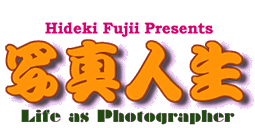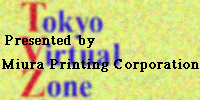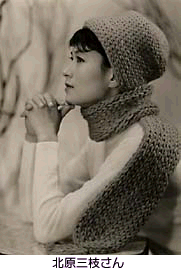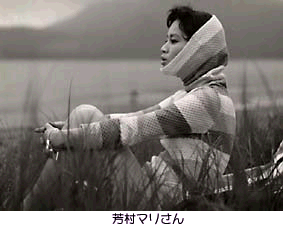TopMenu
 Supported by
Supported by

Mr. Hideki Fujii has played an important role in the world of advertisement photography and ladies' portraits for many years. Recently he has published printed works on photo emulsion for Japanese paper.
Introducing the story of ' a photographer's life', a Mr. whose experience has extended over 40 years .
 Mr.Fujii: Last month I talked about my assistant days so this month I'd like to talk about my employment...
Mr.Fujii: Last month I talked about my assistant days so this month I'd like to talk about my employment...
A new magazine called 'dress' was first published by a female lifestyle publisher in Yushima. There was word that they were asking Doctor Akiyama if one of his apprentices would come and work for them, so Doctor Akiyama approached me and said "It's been 3 years now, if you go to a new place, there probably won't be seniors who give you a hard time,...how about it?!..so I went.
After I got this job, I think it was about 3 months after the first publishing, however there was only 3 of us.. the editor, the sub editor and I. Within these 3 months, I had to take cooking, pregnancy, birth, fashion, every kind of field's pictures! It was such a good experience for me. It's really good if you take various work when you're young. For example I had never taken cuisine photos but, through trial and error I learnt how to show off the glaze and to get good effects on the ice-cream tempura. Everyone thinks if you can eat various cuisine while you're working, it can't be that bad, but it wasn't really like that. For example, making that special fried rice means eating only fried rice for the whole day, and ending up hating it.
At that time, the female publication had an additional attachment which you could say was made up of cooking, sewing, balancing the housekeeping and child care. When it was cooking, I had to take a whole book of photos and as for child education, I had to even take the atmosphere of the birth, but I felt really anaemic and ended up fainting. I was about 25 then, just too much for me!! (laugh)
Other cameramen just weren't there, it was me, singlehandedly doing a whole day shooting cooking, the next day fashion,etc without one day off. In those times I did the black and white processing myself. Most of the female lifestyle publishers had a dark room, but we produced the new magazine in another locality so there wasn't a darkroom. So, I would use the night duty room's bathroom, laying out all the materials on top of the lid and develop them. The lingering steam was just the right temperature and it really was good. In those days, I would hardly go home, the days would revolve around me shooting during the day and developing through the night and then shooting again the next day. Until the first issue was published, I slept in the studio every night.
Shooting a variety of things was possible and it became a good reference for the future. Trying out various things made me realise what fields I really enjoyed. And I really enjoyed the fashion side of photography. When a separate fashion volume came out, it had about 80 pages and I had to take about 40 photos every month. However I had to do everything from developing to beta. It was a tough life so you really had to love the job.
While I was getting paid for the job, I was learning all the time. I say this to the young people, but if you don't decide on your own territory and try and shoot everything, this is still study but out of this you will naturally be able to define your favourites and hates. Old Mr.Akiyama used to say the same things.
In those times, there was very limited 'model' work. It started to increase after about my 3rd year in fashion, so at the start, there weren't any models. Most of the people photographers shot were actresses. At that time, movies were popular so for example even new faces had busy schedules an it was quite hard to take them. We really had to try hard to take actresses. It was like an imaginery world looking back! Even though I took most of the photos for the magazine, I didn't take them for the cover. However I really wanted to. So before long, there was word they would get me to take the magazine cover of the special feature knitting supplements. I was so happy and then they wanted to use Miss Mie Kitahara for the cover. At that time I did have some acquaintances at Akiyama's studio but, it was the time just before 'Taiyoo no kisetsu' so he was a big star. Mr Fujii had been previously at Akiyama's studio, but for the womens lifestyle dress magazine publishing, and for the cover of the knitting special edition, I really wanted Miss Kitahara to do it, so I directly asked him and he replied with 'ok, it's in gratitude for old Fujii, so yes, I'll do it!!'
 Well, I was over the moon. So he would come to the studios of the lifestyle magazine company and take photos, listening to a kickstart cameraman like me...it was great!!
So, even today I still appreciate what Miss Kitahara did.
Well, I was over the moon. So he would come to the studios of the lifestyle magazine company and take photos, listening to a kickstart cameraman like me...it was great!!
So, even today I still appreciate what Miss Kitahara did.
Besides this I became good friends with a model acquaintance Miss Mari Yoshimura. We would shoot work together, go for drives to lakes and generally go out places together. This was really beneficial for my free time later on. Going out with various whos who in magazines helped me build up my name and contacts and I think it was really beneficial for me. I really did build a network of acquaintances.
I was working for this magazine called 'dress' for 3 years. Going to locations, making friends with the models and other various happenings. The staff kept on increasing too. 10 or 20 people entered the company but of course I still was the only cameraman. I did sometimes get some others to help me out, but as much as possible, I tried to di it myself, so my workload kept on increasing. I couldn't cope with the developing side of things, so I got a lab to do it. It was a very busy 3 years.
Editor: Thankyou very much. Next time let's hear about the period which you were at the Japan Design Centre.


 Mr.Fujii: Last month I talked about my assistant days so this month I'd like to talk about my employment...
Mr.Fujii: Last month I talked about my assistant days so this month I'd like to talk about my employment... Well, I was over the moon. So he would come to the studios of the lifestyle magazine company and take photos, listening to a kickstart cameraman like me...it was great!!
So, even today I still appreciate what Miss Kitahara did.
Well, I was over the moon. So he would come to the studios of the lifestyle magazine company and take photos, listening to a kickstart cameraman like me...it was great!!
So, even today I still appreciate what Miss Kitahara did.